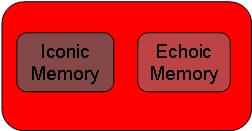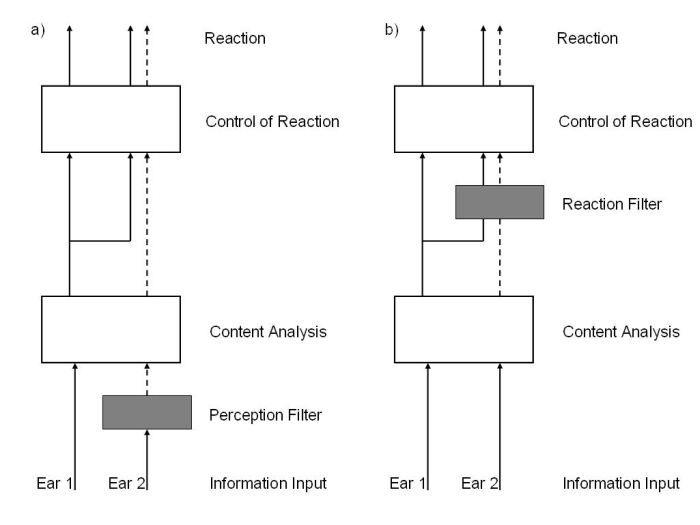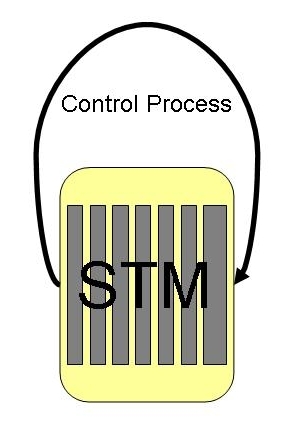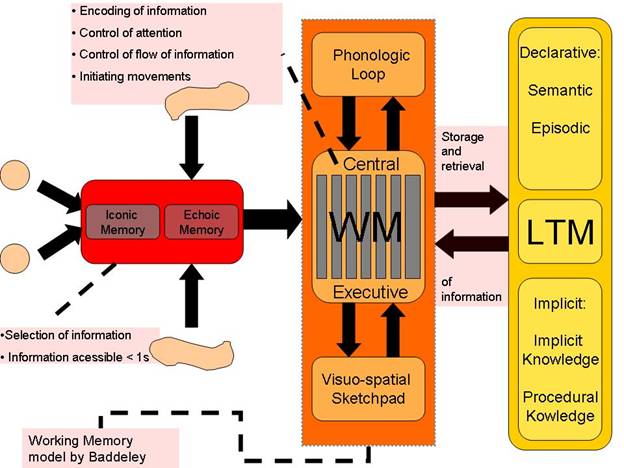6.2: Types of Memory
- Last updated
- Save as PDF
- Page ID
- 91956

- Wikipedia
In the following section, we will discuss the three different types of memory and their respective characteristics: Sensory Memory, Short Term (STM) or Working Memory (WM) and Long Term Memory (LTM).
Sensory Memory
This type of memory has the shortest retention time, only milliseconds to five seconds. Roughly, Sensory Memory can be subdivided into two main kinds:

Sensory Memory
- Iconic Memory (visual input)
- Echoic Memory (auditory input)
While Iconic and Echoic Memory have been well researched, there are other types of Sensory Memory, like haptic, olfactory, etc., for which no sophisticated theories exist so far.
It should be noted, though, that according to the Atkinson and Shiffrin (1968)[2] Sensory Memory was considered to be the same thing as Iconic Memory. Echoic Memory was added to the concept of Sensory Memory due to research done by Darwin and others (1972).[3] Let us consider the following intuitive example for Iconic Memory: Probably we all know the phenomenon that it seems possible to draw lines, figures or names with lighted sparklers by moving the sparkler fast enough in a dark environment. Physically, however, there are no such things as lines of light. So why can we nevertheless see such figures? This is due to Iconic Memory. Roughly speaking, we can think of this subtype of memory as a kind of photographic memory, but one which only lasts for a very short time (milliseconds, up to a second). The image of the light of a sparkler remains in our memory (persistence of vision) and thus makes it seem to us like the light leaves lines in the dark. The term "Echoic Memory", as the name already suggests, refers to auditory input. Here the persistence time is a little longer than with Iconic Memory (up to five seconds).
At the level of Sensory Memory no manipulation of the incoming information occurs, it is transferred to the Working Memory. By ‘transfer’ it is meant that the amount of information is reduced because the capacity of the working memory is not large enough to cope with all the input coming from our sense organs. The next paragraph will deal with the different theories of selection when transferring information from Sensory Memory to Working Memory.
One of the first experiments researching the phenomenon of Attention was the Shadowing Task (Cherry et al., 1953).[4] This experiment deals with the filtering of auditory information. The subject is wearing earphones, getting presented a different story on each ear. He or she has to listen to and repeat out loud the message on one ear (shadowing). When asked for the content of the stories of both ears only the story of the shadowed side can be repeated; participants do not know about the content of the other ear’s story. From these results Broadbent concluded the Filter Theory (1958).[5] This theory proposes that the filtering of information is based on specific physical properties of stimuli. For every frequency there exists a distinct nerve pathway. The attention control selects which pathway is active and can thereby control which information is passed to the Working Memory. This way it is possible to follow the utterance of one person with a certain voice frequency even though there are many other sounds in the surrounding. But imagine a situation in which the so called cocktail party effect applies: having a conversation in a loud crowd at a party and listening to your interlocutor you will immediately switch to listening to another conversation if the content of it is semantically relevant to you, e.g. if your name is mentioned.
So it is found that filtering also happens semantically. The above mentioned Shadowing Task was changed so that the semantic content of a sentence was split up between the ears, and the subject, although shadowing, was able to repeat the whole sentence because he or she was following the semantic content unconsciously.
Reacting to the effect of semantic filtering, new theories were developed. Two important theories are the Attenuation Theory (Treisman, 1964)[6] and the Late Selection Theory (Deutsch & Deutsch, 1963).[7] The former proposes that we attenuate information which is less relevant, but do not filter it out completely. Thereby also semantic information of ignored frequencies can be analyzed but not as efficiently as those of the relevant frequencies. The Late Selection Theory presumes that all information is analyzed first and afterwards the decision of the importance of information is made. Treisman and Geffen did an experiment to find out which one of the theories holds. The experiment was a revision of the Shadowing Task. Again the subjects have to shadow one ear but in contrast they also have to pay attention to a certain sound which could appear on either ear. If the sound occurs the subject has to react in a certain way (for example knock on the table). The result is that the subject identifies the sound on the shadowed ear in 87% of all cases and can only do this in 8% of the cases on the ignored side. This shows that the information on the ignored side must be attenuated since the rate of identification is lower. If the Late Selection Theory were to hold then the subject would have to analyze all information and would have to be able to identify the same amount on the ignored side as on the shadowed side. Since this is not the case the Attenuation Theory by Treisman explains the empirical results more accurately.

Illustration of the Attention Control Model by a) Treisman - Attenuation Theory and b) Deutsch & Deutsch – Late Selection Theory.
Short Term Memory
The Short Term Memory (STM) was initially discussed by Attkinson and Shiffrin (1968).[8] The Short Term Memory is the link between Sensory Memory and Long Term Memory (LTM). Later Baddeley proposed a more sophisticated approach and called the interface Working Memory (WM). We will first look at the classical Short Term Memory Model and then go on to the concept of Working Memory.
As the name suggests, information is retained in the Short Term Memory for a rather short period of time (15–30 seconds).

Short Term Memory
If we look up a phone number in the phone book and hold it in mind long enough for dialling the number, it is stored in the Short Term Memory. This is an example of a piece of information which can be remembered for a short period of time. According to George Miller (1956)[9] the capacity of the Short Term Memory is five to nine pieces of information (The magical number seven, plus or minus two). The term "pieces of information” or, as it is also called, chunk might strike one as a little vague. All of the following are considered as chunks: single digits or letters, whole words or even sentences and the like. It has been shown by experiments also done by Miller that chunking (the process of bundeling information) is a useful method to memorize more than just single items in the common sense. Gobet et al. defined a chunk as "a collection of elements that are strongly associated with one another but are weakly associated with other chunks" (Goldstein, 2005).[10] A very intuitive example of chunking information is the following:
Try to remember the following digits:
- 0 3 1 2 1 9 8 2
But you could also try another strategy to remember these digits:
- 03. 12. 1982.
With this strategy you bundeled eight pieces of information (eight digits) to three pieces with help to remember them as a date schema.
A famous experiment concerned with chunking was conducted by Chase and Simon (1973)[11] with novices and experts in chess playing. When asked to remember certain arrangements of chess pieces on the board, the experts performed significantly better that the novices. However, if the pieces were arranged arbitrarily, i.e. not corresponding to possible game situations, both the experts and the novices performed equally poorly. The experienced chess players do not try to remember single positions of the figures in the correct game situation, but whole bundles of figures as already seen before in a game. In incorrect game situations this strategy cannot work which shows that chunking (as done by experienced chess players) enhances the performance only in specific memory tasks.
- From Short Term Memory to Baddeley’s Working Memory Model
Baddeley and Hitch (1974)[12] drew attention to a problem with the Short Term Memory Model. Under certain conditions it seems to be possible to do two different tasks simultaneously, even though the STM, as suggested by Atkinson and Shiffrin, should be regarded as a single, undivided unit. An example for the performance of two tasks simultaneously would be the following: a person is asked to memorize four numbers and then read a text (unrelated to the first task). Most people are able to recall the four numbers correctly after the reading task, so apparently both memorizing numbers and reading a text carefully can be done at the same time. According to Baddeley and Hitch the result of this experiment indicates that the number-task and the reading-task are handled by two different components of Short Term Memory. So they coined the term "Working Memory" instead of "Short Term Memory" to indicate that this kind of Memory enables us to perform several cognitive operations at a time with different parts of the Working Memory.
Working Memory
According to Baddeley, Working Memory is limited in its capacity (the same limitations hold as for Short Term Memory) and the Working Memory is not only capable of storage, but also of the manipulation of incoming information. Working Memory consists of three parts:
- Phonological Loop
- Visuospatial Sketch Pad
- Central Executive
We will consider each module in turn:
The Phonological Loop is responsible for auditory and verbal information, such as phone numbers, people’s names or general understanding of what other people are talking about. We could roughly say that it is a system specialized for language. This system can again be subdivided into an active and a passive part. The storage of information belongs to the passive part and fades after two seconds if the information is not rehearsed explicitly. Rehearsal, on the other hand, is regarded as the active part of the Phonological Loop. The repetition of information deepens the memory. There are three well-known phenomena that support the idea that the Phonological Loop is specialized for language: The phonological similarity effect, the word-length effect and articulatory suppression. When words that sound similar are confused, we speak of the phonological similarity effect. The word-length effect refers to the fact that it is more difficult to memorize a list of long words and better results can be achieved if a list of short words is memorized. Let us look at the phenomenon of articulatory suppression in a little more detail. Consider the following experiment:
Participants are asked to memorize a list of words while saying "the, the, the ...“ out loud. What we find is that, with respect to the word-length effect, the difference in performance between lists of long and short words is levelled out. Both lists are memorized equally poorly. The explanation given by Baddeley et al. (1986),[13] who conducted this experiment, is that the constant repetition of the word "the" prevents the rehearsal of the words in the lists, independent of whether the list contains long or short words. The findings become even more drastic if we compare the memory-performance in the following experiment (also conducted by Baddeley and his co-workers in 1986):
Participants were again asked to say out loud "the, the, the ..." But instead of memorizing words from a list of short or long words, their task was to remember words that were either spoken to them or shown to them written on paper. The results indicated that the participants’ performances were significantly better if the words were presented to them and not read out aloud. Baddeley concluded from this fact that the performance in a memory task is improved if the two stimuli can be dealt with in distinct components of the Working Memory. In other words, since the reading of words is handled in the Visuospatial Sketch Pad, whereas the saying of "the" belongs to the Phonological Loop, the two tasks do not "block" each other. The rather bad performance of hearing words while speaking could be explained by the fact that both hearing and speaking are dealt with in the Phonological Loop and thus the two tasks conflict with each other, decreasing the performance of memorization.
In the Visuospatial Sketch Pad, visual and spatial information is handled. This means that information about the position and properties of objects can be stored. As we have seen above, performance decreases if two tasks that are dealt with in the same component are to be done simultaneously. Let us consider a further example that illustrates this effect. Brandimonte and co-workers (1992)[14] conducted an experiment where participants were asked to say out loud "la, la, la...“ At the same time they were given the task of subtracting a partial image from a given whole image. The subtraction had to be done mentally because the two images were presented only for a short time. The interesting result was that the performance not only didn't decrease while saying "la, la, la ..." when compared to doing the subtraction-task alone, but the performance even increased. According to Brandimonte this was due to the fact that the subtraction task was easier if handled in the Visuospatial Sketch Pad as opposed to the Phonological Loop (both the given and the resulting pictures were such that they could also be named, i.e. verbalized, a task that belongs to the Phonological Loop). As mentioned above, because of the fact that the subtraction of a partial image from a whole given image is easier if done visually, the performance increased if participants were forced to visually perform that task, i.e. if they were forced to use the component that is suited best for the given task. We have seen that the Phonological Loop and the Visuospatial Sketch Pad deal with rather different kinds of information which nonetheless have to somehow interact in order to do certain tasks. The component that connects those two systems is the Central Executive. The Central Executive co-ordinates the activity of both the Phonological Loop and the Visuospatial Sketch Pad. Imagine the following situation: You are driving a car and your friend in the passenger seat has the map and gives you directions. The directions are given verbally, i.e. they are handled by the Phonological Loop, while the perception of the traffic, street lights, etc. is obviously visual, i.e. dealt with in the Visuospatial Sketch Pad. If you now try to follow the directions given to you by your friend it is necessary to somehow combine both kinds of information, the verbal and the visual information. This important connection of the two components is done by the Central Executive. It also links the Working Memory to Long Term Memory, controls the storage in Long Term Memory and the retrieval from it. The process of storage is influenced by the duration of holding information in Working Memory and the amount of manipulation of the information. The latter is stored for a longer time if it is semantically interpreted and viewed with relation to other information already stored in Long Term Memory. This is called Deep Processing. Pure syntactical processing (reading a text for typos) is called Shallow Processing. Baddeley proposes also further capabilities for the Central Executive:
- Initiating movement
- Control of conscious attention
- Problems which arise with the Working Memory approach
In theory, all information has to pass the Working Memory in order to be stored in the Long Term Memory. However, cases have been reported where patients could form Long Term Memories even though their STM-abilities were severely reduced. This clearly poses a problem to the modal model approach. It was suggested by Shallice and Warrington (1970)[15] that there must be another possible way for information to enter Long Term Memory than via Working Memory.
Long Term Memory
As the name already suggest, Long Term Memory is the system where memories are stored for a long time. "Long" in this sense means something between a few minutes and several years or even decades to lifelong.

Long Term Memory
Similar to Working Memory, Long Term Memory can again be subdivided into different types. Two major distinctions are made between Declarative (conscious) and Implicit (unconscious) Memory. Those two subtypes are again split into two components each: Episodic and Semantic Memory with respect to Declarative Memory and Priming Effects, and Procedural Memory with respect to Implicit Memory. In contrast to Short Term or Working Memory, the capacity of Long Term Memory is theoretically infinite. The opinions as to whether information remains in the Long Term Memory forever or whether information can get deleted differ. The main argument for the latter opinion is that apparently not all information that was ever stored in LTM can be recalled. However, theories that regard Long Term Memories as not being subject to deletion emphasize that there might be a useful distinction between the existence of information and the ability to retrieve or recall that information at a given moment. There are several theories about the “forgetting” of information. These will be covered in the section “Forgetting and False Memory”.
Declarative Memory
Let us now consider the two types of Declarative Memory. As noted above, those two types are Episodic and Semantic Memory. Episodic Memory refers to memories for particular events that have been experienced by somebody (autobiographical information). Typically, those memories are connected to specific times and places. Semantic Memory, on the other hand, refers to knowledge about the world that is not connected to personal events. Vocabularies, concepts, numbers or facts would be stored in the Semantic Memory. Another subtype of memories stored in Semantic Memory is that of the so called Scripts. Scripts are something like blueprints of what happens in a certain situation. For example, what usually happens if you visit a restaurant (You get the menu, you order your meal, eat it and you pay the bill). Semantic and Episodic Memory are usually closely related to one another, i.e. memory of facts might be enhanced by interaction with memory about personal events and vice versa. For example, the answer to the factual question of whether people put vinegar on their chips might be answered positively by remembering the last time you saw someone eating fish and chips. The other way around, good Semantic Memory about certain things, such as football, can contribute to more detailed Episodic Memory of a particular personal event, like watching a football match. A person that barely knows the rules of that game will most probably have a less specific memory for the personal event of watching the game than a football-expert will.
Implicit Memory
We now turn to the two different types of Implicit Memory. As the name suggests, both types are usually active when unconscious memories are concerned. This becomes most evident for Procedural Memory, though it must be said that the distinction between both types is not as clearly cut as in the case of Declarative Memory and that often both categories are collapsed into the single category of Procedural Memory. But if we want to draw the distinction between Priming Effects and Procedural Memory, the latter category is responsible for highly skilled activities that can be performed without much conscious effort. Examples would be the tying of shoelaces or the driving of a car, if those activities have been practiced sufficiently. It is some kind of movement plan. As regards the Priming Effect, consider the following experiment conducted by Perfect and Askew (1994):[16]
Participants were asked to read a magazine without paying attention to the advertisements. After that, different advertisements were presented to them; some had occurred in the magazine, others had not. The participants were told to rate the presented advertisement with respect to different criteria such as how appealing, how memorable or eye-catching they were. The result was that in general those advertisements that had been in the magazine received higher rankings than those that had not been in the magazine. Additionally, when asked which advertisements the participants had actually seen in the magazine, the recognition was very poor (only 2.8 of the 25 advertisements were recognized). This experiment shows that the participants performed implicit learning (as can be seen from the high rankings of advertisements they had seen before) without being conscious of it (as can be seen from the poor recognition rate). This is an example of the Priming Effect.

Final overview of all different types of memory and their interaction

